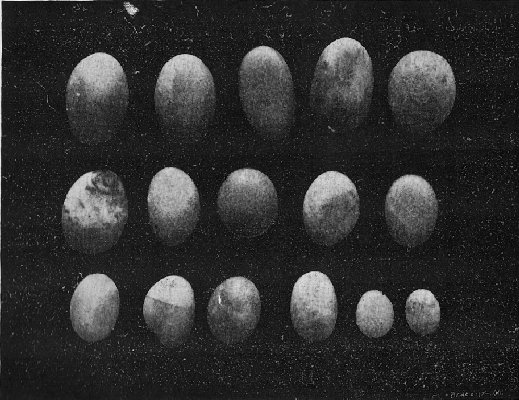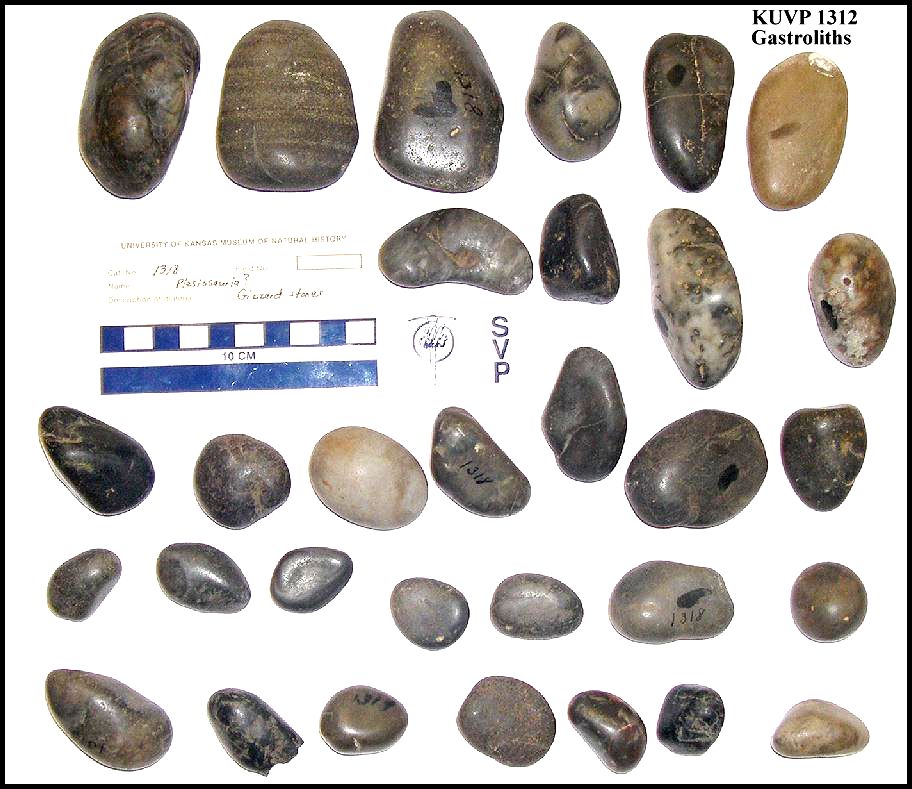121
AN INTERESTING FOOD HABIT OF THE PLESIOSAURS.
BY S. W. WILLISTON, STATE UNIVERSITY, LAWRENCE.
In the report on the geology of Kansas in the First Biennial
Report of the State Board of Agriculture, page 62, by Professor
Mudge, occurs the following: "In the Plesiosauri we found another interesting
feature showing an aid to digestion, similar to many living reptiles and some birds. This
consisted of well-worn siliceous pebbles, from one-fourth to one-half an inch in diameter.
They were the more curious, as we never found such pebbles in the chalk or shales of the
Niobrara." As a member of Professor Mudge's party, I have a very distinct
recollection of the different specimens which afforded these pebbles. The first, found by
myself, had, scattered among the ribs, a quart or more of the stones. The others gave a
less number, but they were found imbedded in the matrix surrounding the ribs. If my memory
is correct, all of the specimens belonged to the genus Polycotylus, and were of
medium size. The conclusion that the pebbles had been in the stomach of the reptiles was
irresistible, and was all the more interesting from the fact, as stated by Mudge, that
such stones were entirely foreign, otherwise, to the chalk.
A little over a year ago, the University museum received
from Mr._____, of Ellsworth, Kas., a large plesiosaur vertebra and, with it, a rounded
pebble, with the request for information concerning both. At the first opportunity, I
visited Ellsworth, and; in company with Mr.________, examined the locality whence they had
been obtained. the bones were found in a poor state of preservation, from the effects of
frost, but, by carefully digging over the loosened shale and soil in which they were
contained, we succeeded in securing about 125 of the pebbles, together with a number of
characteristic bones. Some of the pebbles were attached by the original soft limestone
matrix to the ribs and thoracic vertebrę, so that that there could not be a shadow of
doubt of the contemporaneity of deposition. So remarkable had these strange pebbles
appeared to those persons who had visited the locality, that many had been carried off as
keepsakes, and were called "gizzard stones."
It was estimated that, first and last, but little less than a peck of them had
been found. The saurian is one of the largest of the order, measuring, when alive,
probably not less than 50 feet. Its specific, or even generic, determination is difficult
at present, owing to our lack of knowledge of the allied forms. I believe, however, that
it will prove to be a Trinacromerum. The pebbles are, all of them, extremely
hard, consisting almost wholly of silica. They vary in weight from less than 1 gram to 170
grams, and in their greatest diameters from about one-fourth of an inch to over three
inches. In color they are all conspicuous, either white, black, or pink, and all show a
great amount of abrasion. The smaller ones have been worn into more or less perfect
ellipsoids, and all are quite smooth. The larger ones have rounded angles, indicating a
less amount of abrasion.
The pebbles undoubtedly formed a part of the contents of the stomach of the
saurian, and had as certainly been gathered up by the animal from the distant beaches of
the Benton sea. Professor Mudge states that many reptiles have this habit of swallowing
stones; but in this, I think, he was in error. Certainly no other reptiles of the Kansas
cretaceous have ever presented any evidence whatever of a similar habit, and, I think,
among living reptiles few, except the crocodiles, are known to do so. The reptilian
stomach never presents the strong, muscular structure of the gallinaceous birds, which
thus use hard substances as an aid to digestion.
At first sight, it will seem remarkable that so monstrous an animal could have

PEBBLES FROM PLESIOSAUR STOMACH.
From photograph - natural size.
(Unnumbered plate, Williston 1893 - Note this plate is
not included in the JSTOR pdf)
122
KANSAS ACADEMY OF SCIENCE
retained in its alimentary canal solid objects so small as are some of these
pebbles. But it is known that the crocodiles have a peculiarly small pyloric orifice,
wholly preventing the passage of solid bodies, and all such, when taken into the stomach,
whether bones or stones, must necessarily be digested, or worn down to an extremely small
size, before passing into the intestinal canal. In this respect the pebbles show
conclusively a similar disposition of the parts in the plesiosaurs. The food of the
plesiosaurs must necessarily have been, from the comparatively small size of the mouth and
the absence of any special means to aid in deglutition, the smaller animals that abounded
in or upon the water, and this fact may perhaps account for the need of a more active
digestion. Certainly nothing short of a small stone quarry would have given material aid
to the digestive forces of the mosasaurs.
Not the least interesting fact connected with these pebbles
is the indication they present of a color sense on the part of the reptiles, or, at least,
that they selected the most conspicuous ones. It has been suggested that the stones might
have received their shape from the action of the water, and that they, hence, need not
have been long in the animal's stomach. This, however, is highly improbable; there is too
much uniformity of shape among the smaller ones to have been caused by the action of
water. Furthermore, it would have been hardly possible for the animal to have picked up
such small stones as many of them are, and it is very evident that the stones were not
accidentally swallowed. It is very probable that the pebbles originally were nearly the
size of one's fist.
Yet more interesting is the light that is thrown upon the
geography of the Benton sea at the time of the animal's existence. The red quartzite is
apparently identical with that from Sioux City, and it is Professor Haworth's opinion that
they all came from this reflection, or the region of the Black Hills. This is interesting
both as indicating the shore lines at that time and the roving propensities of the
animals.
|


